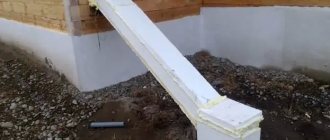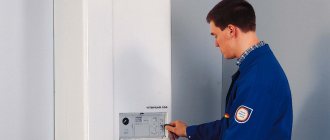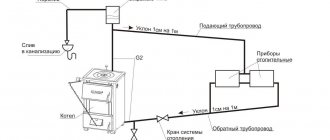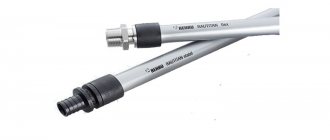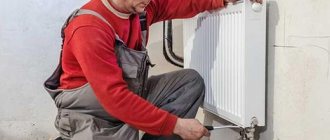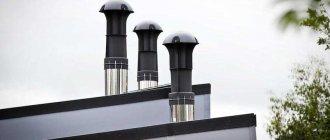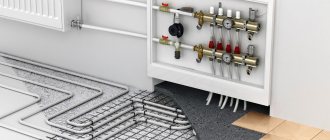Pipe soldering
In order for the pipeline connections to be reliable, installation work must not be carried out at room temperatures below 5 C. All components (pipes, fittings, valves) must be free of contamination and damage. Therefore, it is important to observe safety precautions when transporting and storing the material. It is important to keep open flames away from the material. Otherwise, the pipes and fittings will become deformed and will be unusable. If it is necessary to intersect pipes, you need to use special (triple, cross) fittings. Threaded fittings are installed where there should be a threaded connection. It is unacceptable to cut threads on polypropylene pipes with your own hands. To ensure the tightness and tightness of the threaded connection, use flax tow or FUM tape.
Security measures
When working with a heating device, it is necessary to observe personal protective measures:
- The soldering iron must be installed on a horizontal surface in a place free from materials.
- The technician must wear protective gloves (for working with hot tools) and comfortable overalls.
- Avoid bending over melting plastic as this process releases harmful fumes.
- The room should be relatively clean. The working surface is free from dust and debris.
- The connection between the soldering iron plug and the network must be tight and the cord must be loose.
We recommend that you familiarize yourself with: Tool for installing cross-linked polyethylene pipes
The welding tool is preheated for 20 minutes if it does not have a corresponding indicator.
Materials and tools
Polypropylene pipes PN 10 are intended for cold water supply, PN 20 - for hot water with temperatures up to 80o.
PN 25 pipes, reinforced with aluminum foil and withstanding temperatures of 95 degrees, have been developed especially for heating in a private house with polypropylene.
Polypropylene pipes PN 25 have the following characteristics:
- Melting point - 150 degrees
- Maximum operating pressure - 25 atm
- Density - 0.9 g/cu. cm
- Thermal expansion coefficient - 0.15 mm/mmC
- Thermal conductivity - 0.24 W/mS
- Outer diameter - 21.2 - 77.9 mm
- Inner diameter - 13.2 - 50 mm
- Wall thickness - 4 - 13.3 mm
The advantages of polypropylene pipes for heating are:
- Resistance to corrosion and scale deposits on internal walls
- Pipes do not burst when water freezes
- Low cost
- Light weight
- Plastic
- Resistance to temperature changes
- High level of sound insulation
- Long service life - up to 50 years
Disadvantages include low melting point and exposure to ultraviolet rays.
To install polypropylene heating, you will need the following special tools:
- Soldering iron with a set of nozzles for connecting pipes
- Plastic pipe shears or roller pipe cutter
- Deburring and chamfering cutter
- Shaver for removing foil
Every home must have heating. However, summer houses are an exception. For example, frame garden houses, which are designed for relaxation during the hot season. Therefore, it is not worth installing a heating boiler, because... The summer temperature itself will warm up such a house.
If you plan to relax only in the summer, then you can build such a garden house with your own hands. Read about how to build such a wonderful building here.
Heating boiler piping
There are two options for boilers - floor-mounted and wall-mounted. Connecting them has its own characteristics. The piping scheme common to all types of boilers includes:
- boiler;
- radiator;
- ball valves;
- nuts fixing the boiler;
- cleaning filters;
- thermal heads for batteries;
- tees, corners;
- Mayevsky cranes;
- different valves;
- measuring instruments;
- circulation pump;
- distributors;
- fastener
The piping scheme in the case of a wall-mounted boiler can be exclusively closed, since these boilers are autonomous. A floor-standing boiler cannot be placed at the top of the wiring, since it does not exhaust air. As a result, air pockets will appear. Most wall-mounted boilers have air vents, so they independently release air masses.
When piping a gas boiler with a polypropylene circuit, a large number of connections should not be allowed. The main condition is the presence of a rigid joint at the point where the gas is supplied to the unit. A feature of a solid fuel boiler is the lack of a heat supply control function. When forced circulation is turned off, pressure will increase and the system may fail.
For such cases, there are emergency schemes. One of them is installing an automatic bypass. When the pump is running, the coolant flows through it, and the bypass is closed. When the pump stops, the fluid flow is redirected and passes through the bypass. For heating circuits installed in a private house made of polypropylene with a circulation pump, the feasibility of use and parameters of the latter are determined by hydraulic engineering calculations.
Pipe selection
Before making a selection, you should carefully analyze the specifics of the room, decide on the type of heating system, and also take into account the fact that certain skills and knowledge are required when installing this or that pipeline fittings, consider whether you can do everything yourself or will have to seek help from a specialist .
Types of polypropylene pipes: (1- with aluminum reinforcement, 2- with fiberglass reinforcement).
Manufacturers provide a wide range of products for heating installations made from various materials: metal, metal-plastic, polypropylene, each of which has its own positive and negative sides.
Today, both specialists and non-professionals recognize polypropylene pipes as the most popular and optimal option.
Metal pipeline products are the most expensive, susceptible to corrosion, which, accordingly, reduces their service life, and there are certain difficulties in assembly.
Metal-plastic pipes are well known for their low cost and easy installation process, but they are not strong and durable.
For heating and plumbing systems, the best option is polypropylene pipes, especially when doing the installation yourself. It should be noted that, depending on the purpose of use (heating, hot or cold water supply), pipeline fittings vary significantly in technical characteristics and in no case can be interchangeable.
The wide scope of use of polypropylene pipes is justified by a large number of advantages: reliability and durability (up to one hundred years of operation); corrosion resistance; resistance to chemical influence; protection from mineral deposits; easy installation and subsequent repairs.
And yet this material also has a drawback - low fire resistance.
To make a choice which polypropylene pipes are needed for the heating system, you should choose a diameter that does not affect the water pressure, but also not too wide, since then you will have to overpay unreasonably.
Polypropylene pipes are new opportunities
Products made from PPR have optimal technical characteristics. They open up new opportunities for owners of suburban housing, where the heating system is powered by boilers. Their use reduces the complexity of installation. This option is not only economically beneficial, but also reliable.
Each person understands the word comfort in his own way, but everyone needs warmth. You can provide them to your home without large capital and time expenditures by using polypropylene pipes, and awareness of heating issues will allow you to make the right decision.
Disadvantages and methods for eliminating them
- The main disadvantage of polypropylene pipes is their high expansion coefficient. At a coolant temperature of 100°C, 10 meters of pipe lengthens to 15 cm. This leads to deformation of the structure. In order to prevent destruction, flexible supports are installed and compensation loops are made. Later, foil-reinforced pipes began to be used, which significantly reduced the expansion coefficient. Nowadays, the most practical pipes are reinforced with glass fiber: under the same conditions they extend by only 1 cm.
- Polypropylene products, especially connecting elements, are inferior to metal pipes in strength. It is not even correct to compare them: when subjected to strong impacts with hard objects, polypropylene is deformed and may collapse.
Heating system diagrams
Select the optimal pipe layout for self-installation of polypropylene heating. In the future, you will receive recommendations for connecting individual elements and place them in accordance with the chosen plan.
Single-pipe scheme
Single-pipe scheme
The simplest method of arranging a heating system. In accordance with this wiring method, each battery installed further from the heating unit will heat up to a lower temperature compared to the previously installed battery.
This method makes it possible to reduce the consumption of materials for the arrangement of the heating system. However, the heating efficiency will be low, because The temperature distribution with such pipe routing is uneven.
In view of this, you should try to refrain from a single-pipe pipe routing scheme.
Collector circuit
Collector circuit
To equip a heating system according to this scheme, you will have to spend more materials, however, the basic operational properties of such heating will be much higher.
Heat distribution throughout the rooms will be fairly uniform and high quality.
Two-pipe system
Two-pipe system
The most optimal method of arranging a heating system. The pipes are laid into the floor or into the walls of the house around the perimeter. Two-pipe heating is best suited for heating a home. Therefore, experts recommend giving preference to this particular pipe routing option.
Features of heating system installation
The construction of a heating system based on polypropylene pipes should be carried out in a certain order and in strict accordance with certain recommendations. This will help you avoid some common mistakes and make a truly reliable and practical heating system that will serve well for many years.
We recommend that you read: What is the maximum temperature that a polypropylene pipeline can withstand?
Fitting
Fittings are used to connect different sections of the heating system. Depending on the purpose, shape and diameter, these can be:
- Couplings. The simplest elements used for soldering two sections of pipe of the same diameter.
- Corners. Used for pipeline installation in places where the design provides for a turn. They can be equipped with a thread that allows you to connect terminal devices to them.
- Tees. Fittings designed for installation of several pipes at the same time.
- Adapters. Allows you to connect polypropylene pipes of various diameters into a single network.
Note! Professionals recommend purchasing fittings and pipes from the same manufacturer. This will help ensure maximum compatibility of elements and enhance the reliability of the design.
Wall mount
To avoid pipeline deformation, polypropylene pipes should be securely fastened. It is most convenient to mount it to the wall, maintaining a distance between adjacent fastening points of at least 70 cm.
It is important! Sections of polypropylene pipes that pass through walls may be subject to abrasion over time, so when installing them, a section of the wall should be trimmed with a special passage sleeve.
Radiator mounting
The radiator (especially when filled with water) is quite heavy, so to secure it securely, you should use special elements that come with the battery itself.
It is strictly not recommended to use homemade structures to secure radiators.
Advantages of polypropylene
Pipes and connectors
- the heating system made of polypropylene is not subject to corrosion;
- more reasonable price than metal analogues;
- there are no reactions from exposure to acidic or alkaline environments;
- there is no accumulation of deposits on internal surfaces;
- there are no significant changes in coolant temperature, depending on the microclimate of the room, due to the low thermal conductivity coefficient;
- the movement of the coolant is not accompanied by noise;
- due to the property of plasticity, it is possible to make bends in the required places;
- changes in coolant temperature do not affect the design in any way;
- durability and ease of installation.
The main advantages of polypropylene pipes
If we list all the advantages of polypropylene pipes, it is worth noting their high level of quality, as well as their affordable cost. Heating systems created from these elements will serve their owners well for decades. The use of unique technologies in the manufacture of polypropylene pipes allows us to speak with complete confidence about the high strength of the products.
Polypropylene pipes do not succumb to the negative effects of corrosion during operation, and also perfectly resist mechanical influences from the outside. Dirt and impurities will not accumulate on the pipe walls. Consequently, the water will be clean and transparent for a long period of time.
As for installation, this is another advantage inherent in polypropylene pipes. Installing polypropylene heating with your own hands is not difficult.
Heating system planning
The main components of the system under consideration include the boiler, the pipes themselves, radiators (batteries) and fasteners.
Heating planning scheme for a private house.
Heating elements (or boilers) vary in fuel types and characteristics. Their installation is recommended in a specially designated area (room, outbuilding) with good ventilation and a gas sensor. The boiler must be installed below or at the level of the lowest point of the heating system, in no case higher.
It is necessary to develop a pipe installation project that includes diagrams in all rooms where the heating installation will be organized. If you are going with your own hands, you should remember that you will need additional components, such as angles and angles of rotation, couplings and various adapters. These points must be reflected in the project at each site where these parts will be used according to the plan. In addition, the diagram should indicate the installation locations of radiators and indicate the length of pipes between them.
You should take care of the fasteners for attaching the pipes. Fastening elements are selected in accordance with the type and diameter of pipes, the weight of radiators (batteries).
There are several options for constructing a heating system made of polypropylene. First of all, there are systems with top and bottom spill.
The first method involves the principle of gravity movement of water. In this case, there is no need to install a circulation pump, since the water will flow through the pipes on its own. This type of heating system is effective in cases of frequent power outages, when the use of a pump is excluded.
Bottom-spout heating systems usually involve radial wiring and the use of a pump to increase water pressure. In this case, it becomes possible to use pipes with a smaller diameter, which, accordingly, allows you to save a little.
The next classification option is a division into one- and two-pipe systems with side and bottom connections to radiators (batteries).
Diagrams by type of coolant supply
The radiator will work effectively if the coolant is evenly distributed across all sections.
Warm and cold water have different densities. The heated coolant always tends upward. In the system it is replaced by cold, denser water. This feature is taken into account when supplying coolant to the batteries.
Coolant supply diagram
Upper eyeliner
Each radiator has vertical channels connecting the horizontal upper and lower manifold. The presence of these elements allows the coolant to circulate in the device.
With the top connection, mainly only the top of the battery heats up. To prevent such an effect, a jumper is installed after the first rib in the direction of flow of the coolant. Therefore, the heated water first falls into the lower collector.
Then it passes through all sections of the radiator and enters the return pipeline. As a result, the top connection turns into a diagonal way to connect the battery.
If there is no jumper in the radiator, the supply pipe is connected at the top, and the return pipe at the bottom from the opposite end of the battery. This option is called diagonal strapping.
Bottom eyeliner
This is the easiest way to tie. The scheme involves installing the boiler in the basement or on the ground floor. From the heat generating unit, the main pipeline is led to the attic, where the expansion tank is installed. A starting line is laid from the tank, but not lower than 1.5 m to the first radiator.
The supply and return are connected to the batteries at the lowest points on opposite sides. All radiators in the system are connected to pipelines in the same way and installed in series.
When installing a heating circuit with natural circulation, the pipes are laid at an angle. The last battery must be located above the boiler. The height difference between the final radiator and the heat generating unit should not exceed 3 m.
Connection in progress:
- circulation pump;
- bypasses;
- shut-off valves;
- Mayevsky cranes.
Pumping equipment runs on electricity. When it is turned off, circulation of the coolant is possible only in a natural way. Therefore, it is better to lay pipelines at a slope.
Existing types of polypropylene pipes and their characteristics
Today, manufacturers offer a wide range of polypropylene products. And before purchasing pipes, you should understand their markings and properties.
There are several categories of such products:
- PN-10 - available with an internal diameter of 16.2-90 mm, external diameter - 20-110 mm; For such pipes, thin-walled polypropylene is used (its thickness can be 1.9-10 mm), designed for operating pressure in the system up to 1 MPa and temperature up to 20 0C, therefore it is not used for heating systems.
- PN-20 - such products can have an external/internal diameter of 16-110 mm and 10.6-73.2 mm, respectively; the thickness of their walls is 1.6-18.4 mm; they are designed for operating pressures up to 2 MPa and temperatures up to 80 0C. Despite the fact that this category is considered universal, these pipes in the heating system can only be used in the return pipeline, provided that the coolant temperature does not exceed the previously specified value.
- PN-25 is the best option for heat supply, the distinctive feature of which is multi-layering (the cross-section of the pipe consists of two layers of plastic, between which a thin layer of aluminum treated with glue is laid). Manufactured reinforced products can have an internal/external diameter of 13.5-50 mm and 21.2-77.9 mm, respectively, and a wall thickness of 4.0-13.3 mm. Such polypropylene is capable of functioning in a system with a coolant temperature of up to 95 0C and operating pressure of up to 2.5 MPa.
- PN-16 - can be used for pipelines with coolant temperatures up to 80 0C, however, this variety is not common and therefore is practically not used.
There is another variety: pipes reinforced with fiberglass, which are similar in quality to products with a foil layer. However, the first type has a slightly higher coefficient of thermal expansion, but their installation is somewhat simpler (category PN-25 requires preliminary removal of the foil on the area to be welded if it is located close to the outer surface).
Figure 4 – Polypropylene pipes reinforced with fiberglass
Welding machines for PP pipes
Due to the fact that all pipe connections made of PP material are made by welding, a specially designed welding machine is required to connect them.
Generally applicable options for such welding work:
- With a heater having a circular cross-section;
- a device equipped with a flat heating element.
The latest model is called an “iron” in everyday life due to a certain external resemblance to a popular home device. Various welding machines, in fact, have no fundamental differences, only external structural ones. In the first version, Teflon pipe nozzles are put on and secured to the heating element in the form of clamps, and in the second, they are screwed to the heating element on both sides.
The most important functional part of the welding machine, the heater, can be made in the form of various designs and is designed in such a way that it is possible to install from 2 to 3 pipe nozzles of small cross-section. This makes it possible to save enough time when performing welding work in networks with pipes up to 40 mm. For domestic purposes, experts recommend having an “iron” with a thermal power of up to 1 kW. A welding device with heating elements of more than 1 kW is classified as professional equipment and costs much more.
How to use welding
Before soldering polypropylene pipes, the soldering iron must be placed on a straight plane. Next, nozzles of the required cross-section are attached, which are tightened with special keys included in the delivery set. The nozzle must be placed close to the edge of the connection so that the structure can be welded directly on the walls. It will be more convenient to perform all the disparate parts of the pipe system on stationary welding equipment, which one person can do independently. And you will need an assistant to assemble the parts into a common pipeline line on the wall.
Professional soldering is performed only after the unit has completely warmed up to process temperature, approximately 15 minutes after connecting the device to the network. It is not recommended to unplug the soldering iron during the entire welding process. The two assembly elements are heated synchronously. The plastic that remains on the surfaces of the nozzles after removing the units is removed with tarpaulin material after each installation. Cleaning cold nozzles is not permitted.
Do-it-yourself installation
When installing heating from polypropylene pipes, it is initially necessary to calculate the laying diagrams. With this installation, it is necessary to maintain the slope level to the lowest point of the system, because a tap or valve for draining is installed in this place. The length of pipe sections must be calculated for each section of communication. If the pipeline is divided into sectors that can be shut off individually at any time, the operation of the communication system will become significantly safer. All tools and installation parts must be at room temperature, for which they must be brought into the room immediately before the installation process. This action is necessary to prevent the material from cracking during operation. Using a felt-tip pen, it is necessary to apply marks according to the calculations performed on the measured pipe sections.
You need to cut the polypropylene with your own hands evenly and perpendicular to the surface with special scissors or a pipe cutter, after which the cut edges of the pipe are treated with an alcohol solution, and the rest of the dirt is removed with a dry rag. A nozzle with the appropriate cross-sectional diameter is installed on the soldering apparatus, which must first be degreased, the apparatus is installed horizontally and heated to 260 °C. Pre-prepared parts (pipe and fitting) are placed in the heater holes in a horizontal position, then the time is determined from the table and the parts are heated.
http:
Then the parts are removed, the pipe is inserted into the fitting and a certain period of time is maintained for the elements to completely harden; twisting the parts during the hardening process is prohibited. This method of welding (soldering) parts is reliable and the most durable. Communication parts must be dry and clean when carrying out soldering work; if installation is carried out in a working (operating) system, then the water must be drained from the heating systems. To conduct trial tests of the heating system, you should not purchase water meters; instruments that show the deaeration of pipes are quite sufficient.
Gravity heating system
The classic gravity system folds:
- from the boiler;
- tank;
- pipes;
- radiators.
Its advantages include energy independence, self-regulation, and reliability. There is an opinion that polypropylene pipes are not suitable for constructing such a system, but this is not the case. You just need to meet some conditions during installation:
- The spill must be carried out at a uniform slope throughout.
- After the boiler, a short acceleration section called a collector is required. Here the water picks up speed and continues further circulation. It needs to be framed with a piece of steel pipe so that the coolant can be cooled.
- The radiator must be located as low as possible to the level of the boiler, or at least on a par with it.
- The solid fuel boiler is installed at a slight slope. The pipe is welded into it in the very top corner.
- The outlet pipe is also mounted with a slope at the lowest point.
- Taps with maximum flow are connected to the radiators. This will eliminate losses, and circulation will occur throughout all batteries.
If you plan to install a heated floor, form a gravitational pumpless system for the radiator, and arrange a separate loop with a pump for the floor. Since the system has limited pressure, it will not be able to push through additional complex contours naturally.
Choosing a heating source
Before you begin installing a polypropylene pipeline, you should decide on the heating source. This will affect the overall design of the heating system and the selection of additional elements.
Gas
It is considered a very economical and environmentally friendly type of fuel. However, it is appropriate to talk about efficiency only if the house is already gasified or is at least located near the main gas pipeline. Otherwise, connecting to a remote network will cost the owner a tidy sum.
The best option for installing a heating system using gas fuel is a modern wall-mounted gas boiler, equipped with a set of necessary devices and protective mechanisms that ensure maximum automation of system control processes.
Another advantage of this solution is the ability to abandon the chimney that is so common in private households. Modern gas boilers are equipped with a closed combustion chamber, the supply of oxygen and the removal of exhaust air from which is carried out through a thin tube.
Electricity
Another environmentally friendly way to heat a room, although more expensive than gas. To ensure the operation of the heating system, you will need a special boiler equipped with safety equipment, a pump for circulating coolant (depending on the chosen scheme) and an expansion tank.
Solid fuel systems
They are characterized by a higher coolant temperature at the boiler outlet, which imposes increased requirements on the organization of the safety system.
